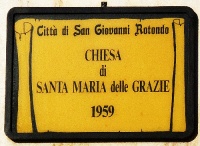 Index
Index

Italy is shaped like a boot, and it has a small peninsula extending into the Adriatic Sea that looks like a spur on the boot. This little peninsula is the location of the Gargano national park and of the communities of San Giovanni Rotondo and Monte Sant'Angelo. The area has a temperate climate with fresh ocean breezes ideal for the cultivation of olive trees and grape vines.

San Giovanni Rotondo is a small community with a population of about 26,000 that has become a pilgrimage destination for devotees of Padre Pio, an Italian Capuchin priest also called Pio of Pietrelcina, and venerated as a saint by the Roman Catholic Church. The city has a state-of-the art medical center, Casa Sollievo della Sofferenza (House for the Relief of Suffering), that opened in 1956 and was founded through the leadership of Padre Pio.




The old church Santa Maria della Grazie (Our Lady of Grace) where Padre Pio celebrated Mass and heard confessions was a small church with a capacity for about 80 people. The door over the old church has a semicircle made of ceramic depicting the Virgin Mary holding baby Jesus. As Padre Pio gained notoriety for his stigmata, the church became too small to accommodate all the pilgrims who came to get a glimpse of him and get his blessing. Construction of a new, much larger church was started adjacent to the old church in July of 1956 and was completed in July of 1959. The main altar of the new church originally had a mosaic depicting only Our Lady of Grace, by prof. Bedini, but after Padre Pio of Pietrelcina was canonized by Pope John Paul II on June 16, 2002, a figure of Padre Pio and an angel in the clouds were added to the design. The basement of the new church served as the crypt for the body of Padre Pio from his death until April of 2010 when his remains were placed in a new metallic coffin and transferred to the crypt of the Padre Pio Pilgrimage Church.

Padre Pio Pilgrimage Church
A short walk behind Santa Maria della Grazie is the
Padre Pio Pilgrimage Church which was dedicated on July 1, 2004.
The Pilgrimage Church has a modern design by architect Renzo Piano of Genoa that
avoids the use of pillars and instead uses parabolic arches to support the large structure.
Some arches covered with stained glass designs are used as walls.
The Padre Pio Pilgrimage Church has a capacity for 6,500 seated persons,
and an additional 30,000 people can stand outside by the external altar.
In the lower level of the Padre Pio Pilgrimage church is the crypt for Padre Pio's remains. A curving hallway whose walls are covered with mosaics leads to the crypt. The mosaics depict events in Padre Pio's life, including his celebration of the Mass, his interaction with other monks, and Padre Pio kneeling in prayer in front of a crucifix while receiving the stigmata.
Padre Pio's crypt has a ceiling made of golden ceramic tiles with indirect lighting that give the room a golden glow. Pilgrims stand in line to pass by Padre Pio's silver coffin lined with bezel settings encrusted with large precious stones of geometric shapes. Pilgrims offer their prayers and touch the coffin as they walk by.
